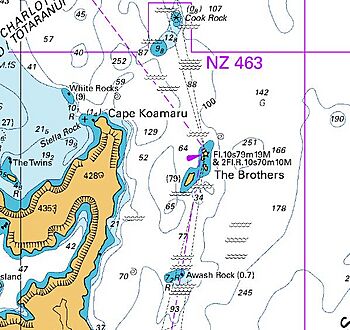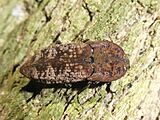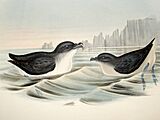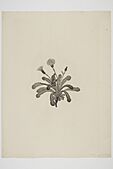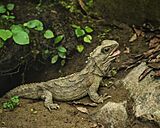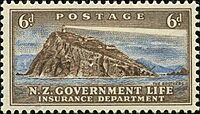The Brothers (New Zealand) facts for kids
The Brothers (Māori: Ngāwhatu-kai-ponu) are a small group of islands in New Zealand. They are found in a place called Cook Strait, near Arapaoa Island. These islands are a special wildlife sanctuary. This means they are protected, and only certain people can visit them. These visits are usually to help the animals and plants that live there.
Contents
Meet the Islands
The Brothers are made up of two main island groups. Each group has one main island and several tiny islets. The two main islands are called North Brother and South Brother.
South Brother is the bigger island. It covers about 9.5 hectares (23.5 acres). North Brother is smaller, at about 4 hectares (10 acres). However, North Brother is a bit taller, reaching 66 meters (217 feet) high. Most of the smaller islets are found in a curve south of North Brother. The largest of these is only about one hectare (2.5 acres) in size.
About 2 nautical miles (3.7 km) south of The Brothers is a spot called Awash Rock. At high tide, you can barely see it. Strong ocean currents flow around this rock. Similar strong currents, with choppy water and swirling whirlpools, are also found between Cape Koamaru and The Brothers.
Island History
The Māori name for these islands is Ngāwhatu-kai-ponu. This name means "the eyes that witnessed." An old story says it refers to the eyeballs of a giant octopus. This octopus, named Te Wheke-a-Muturangi, was fought by a famous explorer named Kupe.
The Māori people thought these islets were tapu, which means sacred or forbidden. If paddlers were crossing Cook Strait for the first time, they would be blindfolded. This was because it was considered bad luck to see the islands on their first trip.
During Captain James Cook's first visit to this area, his ship, HMS Endeavour, almost crashed. A lack of wind and a very strong tide pushed the ship towards the rocks of The Brothers. Luckily, a change in the tide's direction saved the ship from being wrecked.
The Lighthouse on North Brother
The Brothers Island lighthouse stands tall on top of North Brother. This lighthouse was built in 1877. It is New Zealand's only lighthouse built on a rock. It took the place of the old lighthouse on Mana Island.
People first asked for a lighthouse on The Brothers in 1851. This was after a ship called the Maria sank near Cape Terawhiti. Even after a lighthouse was built on Mana Island, many still thought The Brothers was a better spot. In 1867, the ship SS Queen sank after hitting Cook's Rock. This rock is just north of The Brothers. Once the lighthouse opened, Cook's Rock was marked with a red light.
Building the lighthouse was very hard. The island is isolated, and there was no fresh water. Bad weather and rough seas stopped building materials from reaching the island for two months. Workers had to build small huts because tents could not be set up on the rocky ground.
The lighthouse started working on September 24, 1877, using an oil-powered light. In 1954, it was updated to use electricity. This power came from a diesel engine. Then, in 1990, the light was changed again. It became a 50-watt halogen light powered by the sun. At this time, the lighthouse also became fully automated.
Lighthouse keepers lived and worked on the island until August 1990. Since then, the light has been watched from Wellington using computers. Living on the isolated island was very tough for the keepers. Supplies had to be brought in from Picton. The keepers also sent daily weather reports every hour from 4:30 AM until 4 PM.
Amazing Wildlife
- Endangered species on The Brothers
In 1970, The Brothers islands were made a sanctuary. North Brother Island is a special home for a rare type of reptile called the Brothers Island tuatara. This island is also where a rare beetle, the Cook Strait click beetle, was first found. However, this beetle might not live there anymore.
Other special animals and plants found here include the diving petrel. There is also an extremely rare plant that looks like a dandelion, called Kirkianella novae-zealandiae. This plant grows only on North Brother Island and Arapaoa Island.
Staff from the Department of Conservation visit the island about four times a year. They work to remove plants that don't belong there. This helps protect these rare and endangered species.
Other Facts
The Brothers lighthouse was featured on a postage stamp in 1947. This stamp was part of a series about lighthouses from the New Zealand Government Life Insurance Department.
Climate
| Climate data for The Brothers (1991–2020) | |||||||||||||
|---|---|---|---|---|---|---|---|---|---|---|---|---|---|
| Month | Jan | Feb | Mar | Apr | May | Jun | Jul | Aug | Sep | Oct | Nov | Dec | Year |
| Mean daily maximum °C (°F) | 18.7 (65.7) |
18.8 (65.8) |
18.0 (64.4) |
16.3 (61.3) |
14.7 (58.5) |
12.8 (55.0) |
12.0 (53.6) |
12.5 (54.5) |
13.4 (56.1) |
14.7 (58.5) |
15.9 (60.6) |
17.5 (63.5) |
15.4 (59.8) |
| Daily mean °C (°F) | 16.4 (61.5) |
16.7 (62.1) |
15.9 (60.6) |
14.4 (57.9) |
12.9 (55.2) |
11.1 (52.0) |
10.3 (50.5) |
10.7 (51.3) |
11.6 (52.9) |
12.6 (54.7) |
13.7 (56.7) |
15.3 (59.5) |
13.5 (56.2) |
| Mean daily minimum °C (°F) | 14.2 (57.6) |
14.6 (58.3) |
13.8 (56.8) |
12.6 (54.7) |
11.1 (52.0) |
9.4 (48.9) |
8.6 (47.5) |
8.9 (48.0) |
9.7 (49.5) |
10.4 (50.7) |
11.5 (52.7) |
13.1 (55.6) |
11.5 (52.7) |
| Average rainfall mm (inches) | 39.3 (1.55) |
42.3 (1.67) |
42.6 (1.68) |
55.7 (2.19) |
61.8 (2.43) |
80.4 (3.17) |
64.9 (2.56) |
66.4 (2.61) |
62.7 (2.47) |
81.9 (3.22) |
49.0 (1.93) |
49.3 (1.94) |
696.3 (27.42) |
| Source: NIWA | |||||||||||||
See also
 In Spanish: Islas The Brothers para niños
In Spanish: Islas The Brothers para niños



